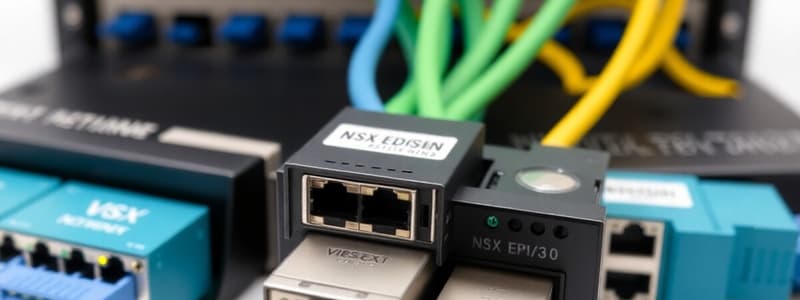Podcast
Questions and Answers
What is the primary purpose of having multiple uplinks in an NSX Edge cluster?
What is the primary purpose of having multiple uplinks in an NSX Edge cluster?
- To reduce the maximum throughput required
- To increase the number of VLANs that can be supported
- To provide redundancy and high availability (correct)
- To connect to a single network switch
Which characteristic is NOT a consideration when configuring uplinks for NSX Edge?
Which characteristic is NOT a consideration when configuring uplinks for NSX Edge?
- Personal user accounts management (correct)
- VLAN tagging requirements
- Supported network interface types
- Maximum throughput matching expected traffic volume
What does a port channel (LAG) do in an NSX Edge cluster?
What does a port channel (LAG) do in an NSX Edge cluster?
- It encrypts traffic over the uplinks
- It is solely used for virtual uplinks
- It simplifies VLAN tagging processes
- It combines multiple physical uplinks into one logical channel (correct)
When configuring uplinks, why is low latency important?
When configuring uplinks, why is low latency important?
What must be configured on the uplinks for NSX Edge cluster's network interfaces?
What must be configured on the uplinks for NSX Edge cluster's network interfaces?
How do uplinks contribute to network segmentation in an NSX Edge environment?
How do uplinks contribute to network segmentation in an NSX Edge environment?
Which configuration can result in a single point of failure for an NSX Edge cluster?
Which configuration can result in a single point of failure for an NSX Edge cluster?
What role do security measures like VLAN tagging and ACLs play in uplink configurations?
What role do security measures like VLAN tagging and ACLs play in uplink configurations?
In an NSX Edge environment, uplinks are typically configured to connect with which of the following?
In an NSX Edge environment, uplinks are typically configured to connect with which of the following?
What is essential for protecting network communication pathways?
What is essential for protecting network communication pathways?
What should be monitored in real-time for uplinks?
What should be monitored in real-time for uplinks?
What is crucial during the initial design phase of NSX Edge deployment regarding uplinks?
What is crucial during the initial design phase of NSX Edge deployment regarding uplinks?
What happens if configurations for uplinks are not documented and reviewed regularly?
What happens if configurations for uplinks are not documented and reviewed regularly?
What should be in place to safeguard against unauthorized network access?
What should be in place to safeguard against unauthorized network access?
What is the role of SNMP monitoring in uplink management?
What is the role of SNMP monitoring in uplink management?
Why is meticulous documentation of uplink configurations important?
Why is meticulous documentation of uplink configurations important?
What should be taken into account concerning virtual uplinks?
What should be taken into account concerning virtual uplinks?
What is one of the main considerations for managing resources allocated to virtual uplinks?
What is one of the main considerations for managing resources allocated to virtual uplinks?
What can be a result of not applying security measures to uplinks?
What can be a result of not applying security measures to uplinks?
What is a significant reason for provisioning multiple uplinks in an NSX Edge cluster?
What is a significant reason for provisioning multiple uplinks in an NSX Edge cluster?
What should uplink ports be configured with to avoid network performance issues?
What should uplink ports be configured with to avoid network performance issues?
Which configuration is recommended to enhance load balancing and redundancy for uplinks?
Which configuration is recommended to enhance load balancing and redundancy for uplinks?
What is essential to ensure logical separation of traffic flows on uplinks?
What is essential to ensure logical separation of traffic flows on uplinks?
What is an important consideration for uplink technology selection?
What is an important consideration for uplink technology selection?
Why is it necessary to configure BGP or OSPF for uplink connections?
Why is it necessary to configure BGP or OSPF for uplink connections?
Which of the following is NOT a reason for monitoring uplink performance metrics?
Which of the following is NOT a reason for monitoring uplink performance metrics?
What can be a consequence of incorrect configuration on uplinks?
What can be a consequence of incorrect configuration on uplinks?
Which performance specification is preferable for uplinks in high-traffic environments?
Which performance specification is preferable for uplinks in high-traffic environments?
Why is careful validation of uplink connectivity configuration necessary?
Why is careful validation of uplink connectivity configuration necessary?
Flashcards
NSX Edge Uplinks
NSX Edge Uplinks
Connections between NSX Edges and the VCF fabric, enabling communication with virtual machines and external networks.
Why are Multiple Uplinks Recommended?
Why are Multiple Uplinks Recommended?
Multiple uplinks provide redundancy and high availability, ensuring continued operation even if one link fails.
Uplink Types
Uplink Types
Uplinks can be either physical, connecting to physical network switches, or virtual, attaching to virtual network switches.
Uplink Throughput
Uplink Throughput
Signup and view all the flashcards
Uplink Latency
Uplink Latency
Signup and view all the flashcards
Port Channel/LAG
Port Channel/LAG
Signup and view all the flashcards
VLAN Support for Uplinks
VLAN Support for Uplinks
Signup and view all the flashcards
Uplink IP Addresses
Uplink IP Addresses
Signup and view all the flashcards
Security Considerations for Uplinks
Security Considerations for Uplinks
Signup and view all the flashcards
Network Segmentation
Network Segmentation
Signup and view all the flashcards
ACLs for Network Security
ACLs for Network Security
Signup and view all the flashcards
Firewall Purpose
Firewall Purpose
Signup and view all the flashcards
Uplink Security Importance
Uplink Security Importance
Signup and view all the flashcards
Monitoring Uplink Performance
Monitoring Uplink Performance
Signup and view all the flashcards
NSX Edge Management
NSX Edge Management
Signup and view all the flashcards
Virtual Uplink Functionality
Virtual Uplink Functionality
Signup and view all the flashcards
Virtual Uplink Configuration Variety
Virtual Uplink Configuration Variety
Signup and view all the flashcards
Virtual Uplink Resource Management
Virtual Uplink Resource Management
Signup and view all the flashcards
Plan for Uplink Growth
Plan for Uplink Growth
Signup and view all the flashcards
Document Uplink Configurations
Document Uplink Configurations
Signup and view all the flashcards
NSX Edge Cluster Uplinks
NSX Edge Cluster Uplinks
Signup and view all the flashcards
Why Multiple Uplinks?
Why Multiple Uplinks?
Signup and view all the flashcards
VLAN or VNI for Uplinks
VLAN or VNI for Uplinks
Signup and view all the flashcards
MTU Configuration
MTU Configuration
Signup and view all the flashcards
High-Speed Uplinks
High-Speed Uplinks
Signup and view all the flashcards
Trunk Protocols for Uplink Connections
Trunk Protocols for Uplink Connections
Signup and view all the flashcards
Importance of Proper Uplink Configuration
Importance of Proper Uplink Configuration
Signup and view all the flashcards
Load Balancing and High Availability
Load Balancing and High Availability
Signup and view all the flashcards
Uplink Security Measures
Uplink Security Measures
Signup and view all the flashcards
vDPs for Uplinks
vDPs for Uplinks
Signup and view all the flashcards
Study Notes
Uplink Requirements for NSX Edge Cluster in VCF 5.2
- NSX Edge clusters require dedicated uplinks for optimal performance and resilience.
- Correct uplink configuration, including bandwidth and QoS parameters, is essential.
- The number of uplinks depends on cluster size and planned workload; multiple uplinks are recommended for redundancy and failover.
- Each uplink should have a dedicated VLAN or VNI for isolation and security, ensuring logical traffic separation.
- Uplink ports need appropriate MTU values to prevent packet loss and performance issues.
- High-speed 10GbE or 40GbE ports are preferred for high-traffic environments.
- Uplinks connect to Layer 2 switches and require trunk protocols (e.g., 802.1Q) for consistent data exchange.
- Correct VLAN tagging, port security, and port channel aggregation on uplinks are essential for connectivity, avoiding disconnections, bottlenecks, or security vulnerabilities.
- For large VM counts, load balancing and high availability strategies for the uplink network should be considered.
- Uplink security measures (e.g., port security, authentication) should align with security policies.
- Virtual Distributed Port Channel (vDP) is recommended for load balancing, redundancy, and high cluster availability.
- BGP or OSPF configuration is important for dynamic routing to edge devices.
- The choice of uplink technology depends on network architecture, infrastructure, and predicted traffic.
- Configuration validation across control plane, data plane, and networking components is critical for cluster functionality.
Types of Uplinks
- Uplink connections can be configured using various interface types:
- Physical uplinks to physical network switches
- Virtual uplinks to virtual network switches.
- The choice depends on the VCF infrastructure setup.
Uplink Considerations
- Maximum throughput: Uplink bandwidth must support VM traffic.
- Latency: Low latency is vital for minimal communication delay.
- Redundancy: Multiple, independent uplinks are crucial for resilience and high availability; avoid single points of failure.
- Security: VLAN tagging, ACLs, and firewall rules are needed for uplink security.
- Network segmentation: NSX Edges segment networks for improved security and control. Uplinks must support this.
Port Channel/LAG
- Using port channels (or LAGs) is recommended to improve throughput and redundancy, combining multiple physical uplinks into a single logical channel.
- The number of uplinks in a port channel depends on redundancy, resilience, and supported network technologies.
VLAN Support
- Uplink configurations must align with the VCF environment's VLAN structure.
- Each uplink might need to support multiple VLANs to accommodate various network segments within the VCF fabric.
- Appropriate VLAN IDs and tagging must be correctly configured.
IP Addresses
- Appropriate IP addresses on uplinks are vital for VCF fabric and external network communication.
- These IP addresses should conform to network design naming conventions and IP blocks.
- Dedicated IP addresses for the NSX Edge cluster's network interfaces are essential.
Network Security and Access Control
- Security measures like ACLs and firewalls must secure uplink communication pathways.
- Secure protocols are crucial for preventing unauthorized access and malicious activity.
Monitoring and Management
- Real-time monitoring of uplink metrics (bandwidth, latency, packet loss) is critical. SNMP monitoring or similar methods should be used.
- Proper management tools are needed to monitor and adjust configurations as required.
Uplink Considerations for Virtual Uplinks
- Virtual uplinks use standard virtual switch functionality within the VCF environment.
- Virtual uplink configuration specifics vary with the VCF virtual switch and its implementation.
- Proper resource provision and management are essential.
Uplink Configuration Best Practices
- Plan uplink configurations during design, considering expected traffic and growth.
- Document all uplink configurations and updates meticulously.
- Regularly review and update configurations for anticipated changes.
Other Considerations
- Monitor uplink performance metrics (bandwidth, packet loss) to identify issues and optimize resources.
- Document uplink configurations and associated VLANs/VNIs for troubleshooting and management during scaling.
- Adhere to VMware best practices and VCF 5.2 documentation for consistency across environments.
Studying That Suits You
Use AI to generate personalized quizzes and flashcards to suit your learning preferences.



